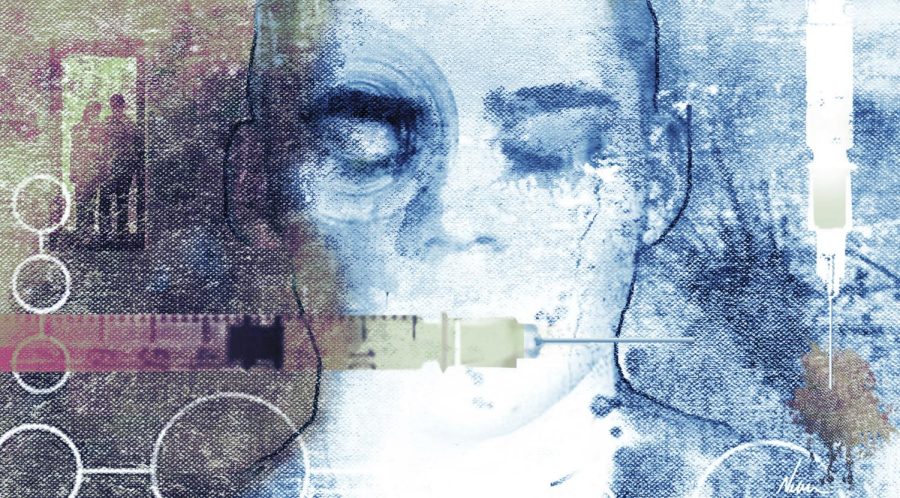Heroin use on the rise in Portage County
May 4, 2016
Portage County Court of Common Pleas Judge Becky Doherty struggles with the decision of whether to keep heroin abusers in custody for their own protection or to let them out.
In one case, she let a male defendant go home overnight for a doctor’s appointment after he had been in the Portage County Jail for two months.
She soon realized the magnetic pull heroin has on addicts.
“He ordered heroin like he would order pizza,” she said. “It was delivered at 3 a.m. And they found him overdosed in the garage.”
Doherty’s decision to keep heroin abusers in custody has consequences, adding to the county jail’s overcrowding problem while offenders wait for treatment beds at the Northeast Ohio Community Alternative Program, or NEOCAP, where the waiting list is about 60 days long.
“If I don’t, I read about them in the paper or the probation officer calls and says, ‘Hey, we lost another one.’ ”
Portage County Sheriff David Doak is on the receiving end of the defendants Doherty and the rest of the judges incarcerate. At one point in February, Doak closed the county jail and accepted only felony and violent misdemeanor cases because the number of inmates was at 228; the jail is certified to handle 218.
Overcrowding in the jail has been a problem for several years and many of the inmates are there because of drugs or drug-related criminal activity.
Officials like Doherty and Doak are dealing with a significant rise in heroin-related incidents. More seriously, the number of heroin deaths in Portage County increased each of the last three years; it ranks fifteenth of 88 counties in Ohio.
An analysis of data from the coroner’s office shows there were 216 drug-related, accidental deaths in Portage County since 2011. Fifty-nine of those deaths involved heroin while others feature what Wayne Enders, the coroner’s office administrator, calls a “cocktail.”
“When (users) buy an illicit drug, they don’t know what’s in that powder or in that cube,” he said. “They think they’re going to have heroin, which they’re accustomed to using,” Enders said, “and they end up using fentanyl because you can’t tell the difference and it’s 50 times stronger and they die almost instantly.”
Project DAWN
Project DAWN classes are held on the second floor of the Portage County Health Department at 705 Oakwood Street in Ravenna. The class is by appointment only and held Mondays from 1-2:30 p.m., Tuesdays from 9-10:30 a.m., and every third Tuesday of the month from 5:30-6 p.m. To make an appointment call Becky Lehman (extension 137) or Kat Holtz (extension 107) at 330-296-9919..
Fentanyl—a more potent, synthetic drug that has similar effects to heroin and morphine—is commonly used to “cut” heroin, which means it’s mixed in to make the drug stronger, combating any tolerance an addict may have. Since mid-2014, twenty-five drug-related deaths have indicated fentanyl use in the autopsy results.
“We’re close to Warren, close to Akron, close to Cleveland, close to Youngstown, so a lot of stuff makes it down here,” said Wayne Enders, the coroner’s office administrator.
In 2014, the National Institute of Drug Abuse reported 10,574 heroin overdose deaths in the U.S., while the Ohio Department of Health reported 1,177 deaths in the state.
“It’s bad everywhere,” Enders said. “This year, we’ve had the most cases in the first four months than we’ve had in any other year.” The coroner’s office is six weeks ahead of the number of cases it had in 2015, a year in which it set a record for total cases.
Overdose Education
Project DAWN, or the Deaths Avoided With Naloxone program, was started by the Portage County Health Department and the Mental Health and Recovery Board of Portage County in September 2015. The free, 30-minute class is designed to help anyone dealing with heroin addiction by offering drug overdose education and naloxone kits.
The class focuses on the signs or symptoms of an overdose, rescue breathing, calling 911, and administering naloxone (also known as Narcan) in an overdose situation.
Naloxone is repeatedly being referred to as the “life-saving drug” and an “opioid antagonist” for its slowing or reversal of opioid effects during an overdose. The naloxone separates the opioid drug from the brain’s receptors and allows the individual to breath again within two to eight minutes.
“Everybody has somebody in their life that’s addicted to heroin … you can’t find somebody who isn’t touched by this,” said Becky Lehman, the director of health, education and promotion for the Portage County Health Department. “I have a personal connection with heroin. Who doesn’t?”
While the heroin epidemic is increasing across the country, heroin isn’t the only opioid that is causing deaths. The less well-recognized dangers may be sitting in household medicine cabinets.
“This is not just about heroin and our bad guys. It’s also about prescription medications as well,” Lehman said.
In February, two toddlers were revived with naloxone after overdosing on prescription pills they found in their Warren, Ohio, home.
“The whole point of Project DAWN is to lower the amount of deaths,” Lehman said. “Are we changing the numbers? I honestly don’t know and it’s too soon for us in Portage County (since we just started) in September.”
The goal may be lowering the death rates from opioids as a whole, but it’s also about giving citizens and other officials a way to fight back.
“I think it’s giving loved ones, family members, peace of mind. That’s huge. If that’s all we did we’d be successful. I think it’s lowering the amounts of deaths … (and) it’s allowing people the second chance to get help and getting into recovery,” Lehman said.
Participants who complete the class will be given a free Project DAWN kit that is provided by the Mental Health and Recovery Board of Portage County.
Jon Huntsman, Mike Mann, Alexandrea Rehner, Max Fleck and Rex Smith reported on this story.












